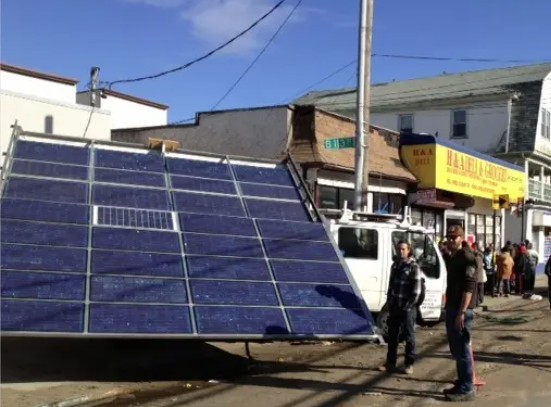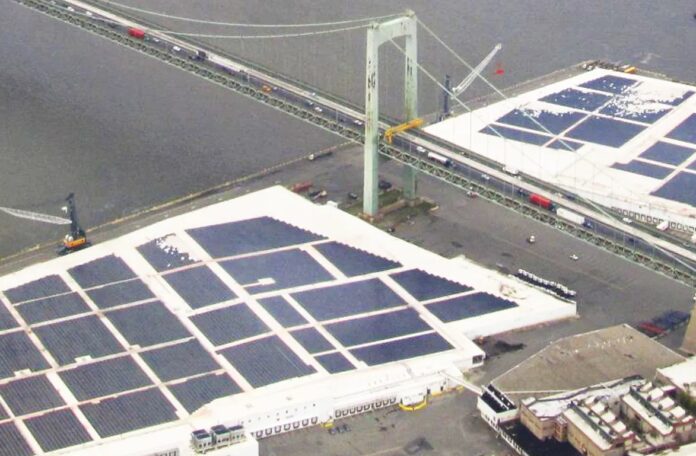Returning guest author, Jane Marsh, is writing today about solar panels and how well the technology can deal with natural disasters. But as you read this posting, note that more than one type of solar panel technology is being deployed worldwide. Last year, a guest author, Enrique Hormillo described various types available from mono and polycrystalline, and perovskite-material-based panels. He also mentioned thin film which includes a dye-sensitized solar (DSCs), or Grätzel cell which I recently learned is made from nanocrystalline mesoporous titanium dioxide. How resilient are any or all of these solar panel systems? Which ones work best in different extreme weather events? Read Jane’s take on the subject and please send us your comments.
Solar panels allow you to be eco-friendly and save on utility bills. The recent Inflation Reduction Act’s passing in the United States is expected to cause a spike in solar panel sales that currently are already receiving rebates and credits from suppliers. But some places on the planet may be more prone to natural disasters, especially coastal and high-wind areas. That’s why solar system owners need to know before installation how well the panels they are buying can withstand natural disasters. Are some more durable than others?
Floods and Storms
Climate change is leading to increasing severe weather events. Rain can cause floods. And above the ground thunderstorms, lightning and hurricanes can wreak havoc on infrastructure. Solar panel technology, however, is proving to be more resilient than in the past because of technologies like micro-inverters placed under rooftop solar panels to optimize their power. This allows homes affected by a natural disaster to operate without battery backup during the day.
Solar panels are waterproof, meaning they can continue to generate electricity even when soaked, feeding generators to prevent blackouts. Their ability to create power from indirect sunlight allows them to work even in cloudy conditions. And rainfall can help remove debris like pollen and dirt on panels to improve their energy conversion efficiency.
However, there are a few considerations related to solar in the face of floods. First, most solar panel wiring systems, like inverters and breaker boxes, are placed close to ground level which means it is important to protect these fixtures from inundation and add flood assistance and prevention technologies.
In non-roof installations, solar panels on the ground can be uprooted if not properly anchored. If you live on flood plain consider the following:
- change the location of your solar installation to move it to higher ground.
- Design a stormwater runoff system or put in retention ponds to capture and remove floodwater
- Build your solar panel installation with higher clearance.
Despite the metal used in solar panels, they don’t increase the risk of any home being prone to a lightning strike. Lightning isn’t actually attracted to metal, and solar panels are usually constructed from glass and aluminum (the latter is s non-magnetic metal).
Blizzards and Hail
Monocrystalline and polycrystalline panels are certified to withstand up to one inch of hail falling at speeds of up to 80 kilometres (50 miles) per hour. In 2017, when Denver suffered from a hailstorm that dropped stones the size of golf balls, it provided an opportunity to analyze the strength of over 3,100 solar panels in the area. Only one installation was affected despite cars and buildings receiving extensive damage. So for the most part solar panels are built strong enough to take a beating.
Snow and ice are of greater concern because when they blanket panels they are unable to generate electricity. Fortunately, Brushing and scraping are the answer to get the panels working again. An interesting fact is that solar panels can perform just as well, if not even better, in snowier environments. And recent advancements have improved the ability of panels to shed ice and snow with coatings of oils, PVC and PDMS plastic.
The biggest safety concern in extreme snow conditions would be the weight-bearing ability of the panels. That’s why manufacturers test the load-bearing strength of their solar panels.
Tornadoes and High Winds
Wind gusts can sneak into the space between your roof and the installed solar panels creating an uplift. With proper installation this is preventable. The likelihood of panel loss would be in extreme wind conditions such as a Category 5 hurricane where gusts would exceed 225 kilometres (140 miles) per hour. Under such conditions, your roof is more likely to blow off along with the solar panels. Most tornadoes never exceed these windspeeds although the highest recorded within a funnel cloud exceeded 480 kilometres (300 miles) per hour.
Solar companies and installers recognize the need to make their panels even more robust in regions prone to natural disasters. Heterojunction solar cell technology (HJT) combines monocrystalline with a thin film to withstand high winds and work well in low-light conditions. These types of panels became more popular after significant storms like Hurricane Maria. The State of Florida requires solar companies to guarantee that their installations can withstand above-average wind gusts up to 274 kilometres (170 miles) per hour.
Another concern about high wind events is that they can cause sandstorms and haboobs. But as long as the wind speeds don’t exceed the upper limits, the only consequence for solar panels is the debris that will land on their surfaces reducing their conversion efficiency.
Earthquakes and Wildfires
California is prone to earthquakes. California homes, therefore, are susceptible to the kind of damage earth-shaking events can do. That means their rooftop solar arrays are equally susceptible. Obviously, extra precaution by solar installers is needed there and the state doesn’t allow for solar installations to be constructed directly over areas on seismic faults. Japan, which is also in an earthquake zone is promoting innovative monocrystalline foldable panels with disaster prevention in mind.
Wildfires produce ash which acts very much like the blown sand we described earlier that can accompany windstorms in dry areas. Ash decreases solar irradiance as does the smoke from wildfires reducing solar panel efficiency. Panels can also catch fire. Panels are fire-rated based on superstrate material and frame type. So if you live in an area where wildfires happen and want to install rooftop solar, talk to your contractor about which panels would be best.
Solars Panels in Natural Disasters

With climate change and the pursuit of renewable energy, improving solar panel efficiency is a high global priority. When Hurricane Sandy struck Long Island, the Jersey Shore and New York City, entire neighbourhoods lost power for days. Among the first emergency energy technology deployed was portable solar panels (see the above picture). Solar panels are for many remote places a viable energy source replacing diesel generators that require the transportation of increasingly expensive fossil fuels and that put carbon into the atmosphere.
And in the very near future, we may even see wearable perovskite solar panels that can be applied to clothing, tent walls, curtains and almost any other surface as a first-response energy solution.









